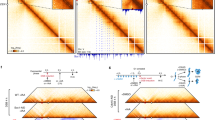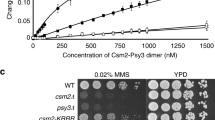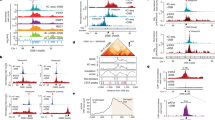Abstract
Human RAD51 and RAD54 are key players in homologous recombination, a process that requires homology recognition and strand invasion by a RAD51–single-stranded DNA (ssDNA) nucleoprotein filament and chromatin remodeling by RAD54. Here we use in vitro chromatin reconstitution systems to show that RAD51-ssDNA stimulates RAD54-dependent chromatin remodeling in a homology-dependent, polarity-independent manner. This stimulation was not seen with RAD54B or other remodelers. Chromatin remodeling by RAD54 enabled strand invasion by RAD51-ssDNA on nucleosomal templates, which was homology- and polarity-dependent. Three natural RAD54 mutants found in primary cancer cells showed specific defects in remodeling or in the RAD54-RAD51 interaction. We propose that RAD54 is recruited by RAD51-ssDNA filament to the chromatin of the intact chromosome and that it remodels that chromatin to facilitate accessibility for strand exchange.
This is a preview of subscription content, access via your institution
Access options
Subscribe to this journal
Receive 12 print issues and online access
$189.00 per year
only $15.75 per issue
Buy this article
- Purchase on Springer Link
- Instant access to full article PDF
Prices may be subject to local taxes which are calculated during checkout






Similar content being viewed by others
References
Neale, M.J. & Keeney, S. Clarifying the mechanics of DNA strand exchange in meiotic recombination. Nature 442, 153–158 (2006).
Michel, B. et al. Rescue of arrested replication forks by homologous recombination. Proc. Natl. Acad. Sci. USA 98, 8181–8188 (2001).
Tarsounas, M. & West, S.C. Recombination at mammalian telomeres: an alternative mechanism for telomere protection and elongation. Cell Cycle 4, 672–674 (2005).
Couedel, C. et al. Collaboration of homologous recombination and nonhomologous end-joining factors for the survival and integrity of mice and cells. Genes Dev. 18, 1293–1304 (2004).
Mills, K.D. et al. Rad54 and DNA Ligase IV cooperate to maintain mammalian chromatid stability. Genes Dev. 18, 1283–1292 (2004).
Baumann, P. & West, S.C. Role of the human RAD51 protein in homologous recombination and double- stranded-break repair. Trends Biochem. Sci. 23, 247–251 (1998).
Heyer, W.D., Li, X., Rolfsmeier, M. & Zhang, X.P. Rad54: the Swiss Army knife of homologous recombination? Nucleic Acids Res. 34, 4115–4125 (2006).
Tan, T.L., Kanaar, R. & Wyman, C. Rad54, a Jack of all trades in homologous recombination. DNA Repair (Amst.) 2, 787–794 (2003).
Van Komen, S., Petukhova, G., Sigurdsson, S., Stratton, S. & Sung, P. Superhelicity-driven homologous DNA pairing by yeast recombination factors Rad51 and Rad54. Mol. Cell 6, 563–572 (2000).
Mazin, A.V., Alexeev, A.A. & Kowalczykowski, S.C. A novel function of Rad54 protein. Stabilization of the Rad51 nucleoprotein filament. J. Biol. Chem. 278, 14029–14036 (2003).
Solinger, J.A., Kiianitsa, K. & Heyer, W.D. Rad54, a Swi2/Snf2-like recombinational repair protein, disassembles Rad51:dsDNA filaments. Mol. Cell 10, 1175–1188 (2002).
Bugreev, D.V., Mazina, O.M. & Mazin, A.V. Rad54 protein promotes branch migration of Holliday junctions. Nature 442, 590–593 (2006).
Alexeev, A., Mazin, A. & Kowalczykowski, S.C. Rad54 protein possesses chromatin-remodeling activity stimulated by the Rad51-ssDNA nucleoprotein filament. Nat. Struct. Biol. 10, 182–186 (2003).
Alexiadis, V., Lusser, A. & Kadonaga, J.T. A conserved N-terminal motif in Rad54 is important for chromatin remodeling and homologous strand pairing. J. Biol. Chem. 279, 27824–27829 (2004).
Wolner, B. & Peterson, C.L. ATP-dependent and ATP-independent roles for the Rad54 chromatin remodeling enzyme during recombinational repair of a DNA double strand break. J. Biol. Chem. 280, 10855–10860 (2005).
Jaskelioff, M., Van Komen, S., Krebs, J.E., Sung, P. & Peterson, C.L. Rad54p is a chromatin remodeling enzyme required for heteroduplex DNA joint formation with chromatin. J. Biol. Chem. 278, 9212–9218 (2003).
Wesoly, J. et al. Differential contributions of mammalian Rad54 paralogs to recombination, DNA damage repair, and meiosis. Mol. Cell. Biol. 26, 976–989 (2006).
Mazin, A.V., Bornarth, C.J., Solinger, J.A., Heyer, W.D. & Kowalczykowski, S.C. Rad54 protein is targeted to pairing loci by the Rad51 nucleoprotein filament. Mol. Cell 6, 583–592 (2000).
Narlikar, G.J., Phelan, M.L. & Kingston, R.E. Generation and interconversion of multiple distinct nucleosomal states as a mechanism for catalyzing chromatin fluidity. Mol. Cell 8, 1219–1230 (2001).
Logie, C. & Peterson, C.L. Catalytic activity of the yeast SWI/SNF complex on reconstituted nucleosome arrays. EMBO J. 16, 6772–6782 (1997).
Polach, K.J. & Widom, J. Restriction enzymes as probes of nucleosome stability and dynamics. Methods Enzymol. 304, 278–298 (1999).
Hamiche, A., Sandaltzopoulos, R., Gdula, D.A. & Wu, C. ATP-dependent histone octamer sliding mediated by the chromatin remodeling complex NURF. Cell 97, 833–842 (1999).
Langst, G. & Becker, P.B. ISWI induces nucleosome sliding on nicked DNA. Mol. Cell 8, 1085–1092 (2001).
Fan, H.Y., He, X., Kingston, R.E. & Narlikar, G.J. Distinct strategies to make nucleosomal DNA accessible. Mol. Cell 11, 1311–1322 (2003).
Mazina, O.M. & Mazin, A.V. Human Rad54 protein stimulates DNA strand exchange activity of hRad51 protein in the presence of Ca2+. J. Biol. Chem. 279, 52042–52051 (2004).
Sung, P. & Robberson, D.L. DNA strand exchange mediated by a RAD51-ssDNA nucleoprotein filament with polarity opposite to that of RecA. Cell 82, 453–461 (1995).
Matsuda, M. et al. Mutations in the RAD54 recombination gene in primary cancers. Oncogene 18, 3427–3430 (1999).
Smirnova, M., Van Komen, S., Sung, P. & Klein, H.L. Effects of tumor-associated mutations on Rad54 functions. J. Biol. Chem. 279, 24081–24088 (2004).
Hsieh, P., Camerini-Otero, C.S. & Camerini-Otero, R.D. The synapsis event in the homologous pairing of DNAs: RecA recognizes and pairs less than one helical repeat of DNA. Proc. Natl. Acad. Sci. USA 89, 6492–6496 (1992).
Alexiadis, V. & Kadonaga, J.T. Strand pairing by Rad54 and Rad51 is enhanced by chromatin. Genes Dev. 16, 2767–2771 (2002).
Sigurdsson, S., Van Komen, S., Petukhova, G. & Sung, P. Homologous DNA pairing by human recombination factors Rad51 and Rad54. J. Biol. Chem. 277, 42790–42794 (2002).
Thoma, N.H. et al. Structure of the SWI2/SNF2 chromatin-remodeling domain of eukaryotic Rad54. Nat. Struct. Mol. Biol. 12, 350–356 (2005).
Golub, E.I., Gupta, R.C., Haaf, T., Wold, M.S. & Radding, C.M. Interaction of human rad51 recombination protein with single-stranded DNA binding protein, RPA. Nucleic Acids Res. 26, 5388–5393 (1998).
Raschle, M., Van Komen, S., Chi, P., Ellenberger, T. & Sung, P. Multiple interactions with the Rad51 recombinase govern the homologous recombination function of Rad54. J. Biol. Chem. 279, 51973–51980 (2004).
Folta-Stogniew, E., O'Malley, S., Gupta, R., Anderson, K.S. & Radding, C.M. Exchange of DNA base pairs that coincides with recognition of homology promoted by E. coli RecA protein. Mol. Cell 15, 965–975 (2004).
Gupta, R.C., Folta-Stogniew, E., O'Malley, S., Takahashi, M. & Radding, C.M. Rapid exchange of A:T base pairs is essential for recognition of DNA homology by human Rad51 recombination protein. Mol. Cell 4, 705–714 (1999).
Voloshin, O.N. & Camerini-Otero, R.D. Synaptic complex revisited; a homologous recombinase flips and switches bases. Mol. Cell 15, 846–847 (2004).
Swagemakers, S.M., Essers, J., de Wit, J., Hoeijmakers, J.H. & Kanaar, R. The human RAD54 recombinational DNA repair protein is a double-stranded DNA-dependent ATPase. J. Biol. Chem. 273, 28292–28297 (1998).
Tanaka, K., Kagawa, W., Kinebuchi, T., Kurumizaka, H. & Miyagawa, K. Human Rad54B is a double-stranded DNA-dependent ATPase and has biochemical properties different from its structural homolog in yeast, Tid1/Rdh54. Nucleic Acids Res. 30, 1346–1353 (2002).
Yoon, D., Wang, Y., Stapleford, K., Wiesmuller, L. & Chen, J. P53 inhibits strand exchange and replication fork regression promoted by human Rad51. J. Mol. Biol. 336, 639–654 (2004).
Aalfs, J.D., Narlikar, G.J. & Kingston, R.E. Functional differences between the human ATP-dependent nucleosome remodeling proteins BRG1 and SNF2H. J. Biol. Chem. 276, 34270–34278 (2001).
Owen-Hughes, T. & Workman, J.L. Remodeling the chromatin structure of a nucleosome array by transcription factor-targeted trans-displacement of histones. EMBO J. 15, 4702–4712 (1996).
Shrader, T.E. & Crothers, D.M. Artificial nucleosome positioning sequences. Proc. Natl. Acad. Sci. USA 86, 7418–7422 (1989).
Acknowledgements
We thank R. Kanaar (Erasmus MC), J. Chen (University of Delaware) and K. Miyagawa (Hiroshima University) for plasmids pFASTBac1/6His-HHR54-HA, pTrcHisB/hRAD51 and pFASTBacHTc/6His-RAD54B, respectively, the members of the Kingston laboratory for critical comments and J. Garlick for help with the Sf9 cell culture. This work was supported by US National Institutes of Health, National Cancer Institute grant CA-093660 (H.-Y.F) and US National Institutes of Health grant GM48405 (R.E.K.).
Author information
Authors and Affiliations
Contributions
Z.Z. designed and executed the experiments. H.-Y.F. established and optimized the mononucleosome-related experiments. J.A.G. optimized the REA reactions on nucleosomal arrays. Z.Z. and R.E.K. interpreted the data and prepared the manuscript.
Corresponding author
Ethics declarations
Competing interests
The authors declare no competing financial interests.
Supplementary information
Supplementary Fig. 1
Recombinant proteins purified from Sf9 cells. (PDF 110 kb)
Supplementary Fig. 2
Control reactions for the remodeling activity of RAD54 and RAD54B. (PDF 276 kb)
Supplementary Fig. 3
RAD51-ssDNA enhances the chromatin-remodeling activity of RAD54 specifically. (PDF 101 kb)
Supplementary Fig. 4
Stoichiometry of RAD51-ssDNA stimulation to the remodeling of the G5E4 array by RAD54. (PDF 132 kb)
Supplementary Fig. 5
Nucleosome occupancy on the G5E4 circular chromatin. (PDF 157 kb)
Supplementary Fig. 6
The effects of different chromatin-remodeling enzymes on strand invasion by RAD51-ssDNA. (PDF 122 kb)
Supplementary Table 1
Vmax of ATP hydrolysis and Km for different substrates, derived from ATPase assays. (PDF 54 kb)
Supplementary Table 2
Sequences of oligonucleotides used for RAD51-ssDNA filament assembly. (PDF 50 kb)
Rights and permissions
About this article
Cite this article
Zhang, Z., Fan, HY., Goldman, J. et al. Homology-driven chromatin remodeling by human RAD54. Nat Struct Mol Biol 14, 397–405 (2007). https://doi.org/10.1038/nsmb1223
Received:
Accepted:
Published:
Issue Date:
DOI: https://doi.org/10.1038/nsmb1223
This article is cited by
-
RAD54L promotes progression of hepatocellular carcinoma via the homologous recombination repair pathway
Functional & Integrative Genomics (2023)
-
New insights into the mechanism of RPA in preserving genome stability
Genome Instability & Disease (2022)
-
Chromatin architecture may dictate the target site for DMC1, but not for RAD51, during homologous pairing
Scientific Reports (2016)
-
DNA double-strand breaks alter the spatial arrangement of homologous loci in plant cells
Scientific Reports (2015)
-
Nap1 stimulates homologous recombination by RAD51 and RAD54 in higher-ordered chromatin containing histone H1
Scientific Reports (2014)



